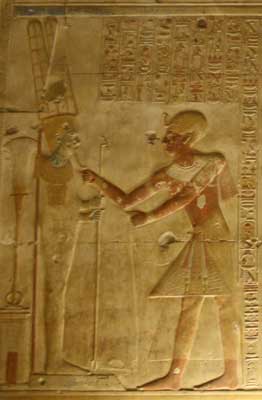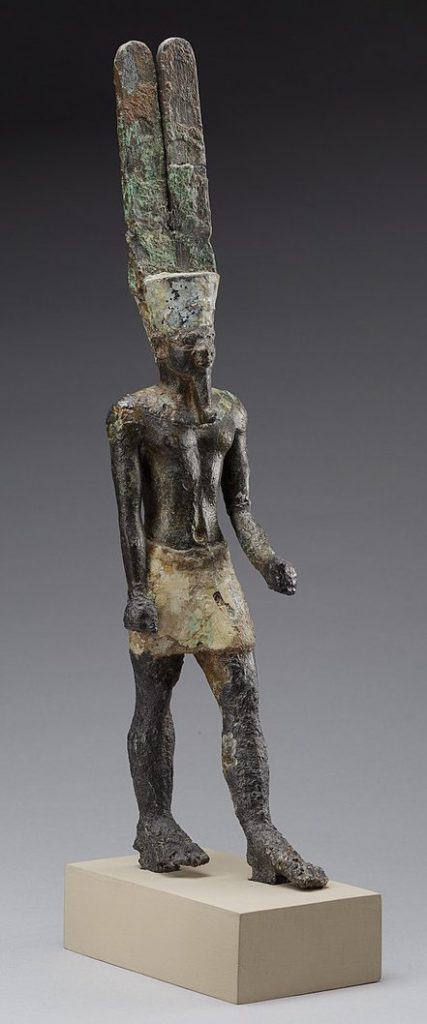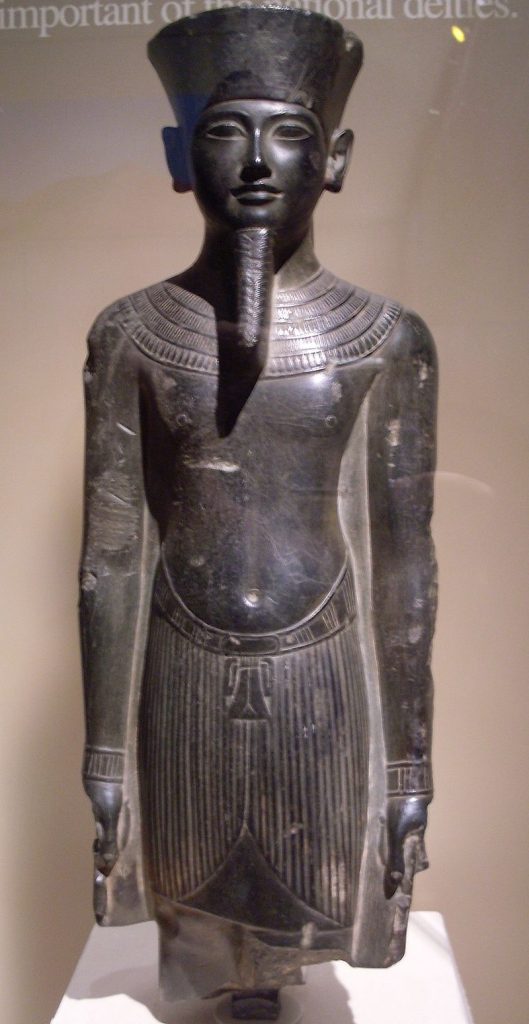
Amun was one of the eight ancient Egyptian gods who formed the Ogdoad of Hermopolis. He was the god of the air and his consort was Ament (Amaunet). However, during the Twelfth dynasty (Middle Kingdom) Amun was adopted in Thebes as the King of the gods with Mut as his consort. Amun and Mut had one child, the moon god Khonsu. He was promoted to national god by Ahmose I, the first pharaoh of the New Kingdom because the king believed that Amun had helped him drive the Hyksos from Egypt. He was also adopted into the Ennead of Heliopolis when he merged with the ancient sun god (Ra) to become Amun-Ra.

It is possible that there were once two separate gods with the same name, but equally likely that Amun of Heliopolis merely took on the attributes of the Theban god Montu (Montju) when he replaced him as the principle god of the nome in the later period.

His name is generally translated as “the hidden one” or “the secret one” and it was thought that he created himself and then created everything else while remaining distanced and separate from the world. In that sense, he was the original inscrutable and indivisible creator. When he merged with Ra he became both a visible and invisible deity. This duality (the hidden god and the visible sun) appealed to the Egyptian concept of balance and duality leading to an association between Amun-Ra and Maat.

Amun was also identified with Montu (who he pretty much absorbed) and the hybrid gods Amun–Ra–Atum, Amun-Ra-Montu, Amun-Re-Horakhty and Amun-Min.
Amun was associated with a number of animals, whose form he sometimes took in inscriptions. Originally, he was depicted as a goose and given the epithet the “Great Cackler” (like Geb). It was also thought that he could regenerate himself by becoming a snake and shedding his skin.
However, he was most frequently depicted as a Ram, a symbol of fertility. He is also depicted as a man with the head of a ram, a frog, an Uraeus (royal cobra), a crocodile, or as an ape. Finally, he is depicted as a king sitting on his throne wearing the double plumed crown (also associated with Min). During the Ptolemaic period, images of Amun were cast in bronze in which he was depicted as bearded man with four arms, the body of a beetle, the wings of a hawk, the legs of a man, and the paws and claws of a lion.

Amun is described as the primeval creator in the Pyramid Texts which depict him as a primeval deity and a symbol of creative force. However, he rose to prominence during the Eleventh dynasty when he replaced the Theban war god, Montu, as the principle deity of the city. From that point, the fortunes of the God were closely linked to the prominence of Thebes itself. When the Theban Ahmose I successfully expelled the Hyksos from Egypt, he was quick to show his gratitude to Amun and throughout the Middle Kingdom the Royal family established temples to Amun, most notably the Luxor Temple and the Great Temple at Karnak. During the New Kingdom, he gained such power that one could almost view Egypt as a monotheistic state.

Amun-Ra was considered to be the father and protector of the pharaoh, and the priests of Amun controlled an impressive proportion of Egyptian land and resources. The Theban royal women also wielded great power and influence and were closely involved with the cult of Amun. Queen Ahmose Nefertari (the Great Wife of the Pharaoh Ahmose I) was granted the title “God’s Wife of Amun” with reference to the myth that Amun created the world through masturbation. This title was then granted to the Great Wife of every Pharaoh in recognition of her role in the state religion of Amun. The female Pharaoh Hatshepsut went one stage further and specifically stated that Amun had impregnated her mother (in the guise of the Pharaoh Thuthmoses II, her father). Thus she established her right to rule on the basis that she was his daughter.
However, the god could also reveal his will through the oracles, who were in the control of the priests and they had been granted so much land that they even rivalled the power of the Pharaoh. Amenhotep III instituted some reforms when he became concerned that the Theban clergy had become too powerful, but his son (Akhenaten) went further and actually replaced Amun with the Aten, and constructed a new capital city named Akhetaten. However, the experiment was short-lived and both Amen and Thebes were reinstated under the rule of Tutankhamun.

The worship of Amun even spread into neighbouring countries, particularly Nubia. By the Twenty-fifth dynasty.Amen-Ra was the principle god of the Kingdom of Napata (Nubia) who believed he came from Gebel Barkal (in northern Sudan) and the Greeks considered him to be the equivalent of Zeus.
His main celebration was the Opet festival, in which the statue of Amun traveled down the Nile from the temple of Karnak to the temple of Luxor to celebrate Amun’s marriage to Mut (or Taweret). In this festival he had a procreative function epitomised in his title “Ka-mut-ef” (“bull of his mother”).
Bibliography
- Pinch, Geraldine (2002) Handbook Egyptian Mythology
- Redford Donald B (2002) Ancient Gods Speak
- Strudwick, Nigel and Helen (1999) Thebes in Egypt
- Van De Mieroop, Marc (1999) A History of Ancient Egypt
- Watterson, Barbara (1996) Gods of Ancient Egypt
- Wilkinson, Richard H. (1992) Reading Egyptian Art
- Wilkinson, Richard H. (2003) The Complete Gods and Goddesses of Ancient Egypt
- Wilkinson, Richard H. (2000) The Complete Temples of Ancient Egypt
copyright J Hill 2008